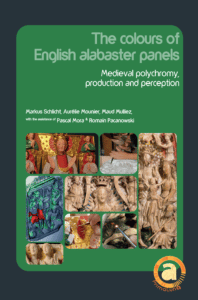UN@ est une plateforme d'édition de livres numériques pour les presses universitaires de Nouvelle-Aquitaine
Collection : PRIMALUNA_22
The research presented here was carried out between 2017 and 2020 as part of the interdisciplinary programme “Polychromy, pigments, perception: late medieval English alabasters preserved in Aquitaine”, funded by the Laboratory of Excellence Archaeological Sciences of Bordeaux (ANR-10-LabX-52).
During the last two centuries of the Middle Ages, between about 1330 and 1530, English sculptors exploited the alabaster deposits in the Midlands on a large scale to create funerary monuments with recumbents, altarpieces and small devotional reliefs
The medieval English alabasters preserved in the south-west of France have already been the subject of several research works. However, these studies are often outdated and some are unpublished.
Is the polychromy of the Libourne panel representative of other English panels, or is this one a case apart? Are the choices of colour and aesthetic choices common or unusual? An examination of the other English alabasters in the Aquitaine corpus will provide answers to these questions.
Is the polychromy of the Libourne panel representative of other English panels, or is this one a case apart? Are the choices of colour and aesthetic choices common or unusual? An examination of the other English alabasters in the Aquitaine corpus will provide answers to these questions.
The panel depicting the Assumption of the Virgin, kept in the Musée d’Aquitaine in Bordeaux, stands out from the English panels examined so far. It displays many atypical features, starting with the way in which the iconographic theme has been treated
While in the previous chapters we have studied the pigments and colours used on English alabasters, their standardised use, the aesthetic principles governing their combination and their moral codification, we have not yet considered the properties and visual effects produced by medieval polychromies.
Les albâtres anglais de la fin du Moyen Âge, qui connurent un vif succès à l’échelle européenne, ont trouvé de nombreux acquéreurs dans le Sud-Ouest de la France.
Intimately combining plastic forms and colours, English alabasters can be termed ‘three-dimensional paintings’. Both components of the works of art contribute equally to the encoding of the religious message they convey and disseminate.
The colours of English alabaster panels – Bibliography
The colours of English alabaster panels – Image credits
Between c. 1350 and 1550, English sculptors carved thousands of panels depicting religious scenes from alabaster quarries around Nottingham. Exported throughout Europe, these polychrome reliefs were originally usually assembled to form altarpieces. Their coloured epidermis, an integral part of these works that can be termed three-dimensional paintings, has now often disappeared.


